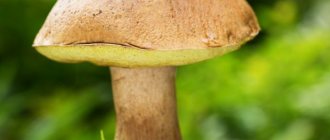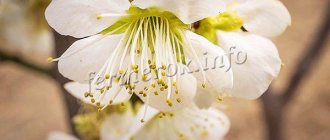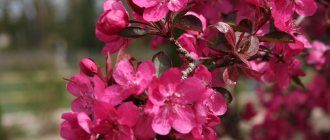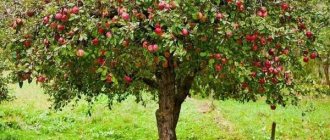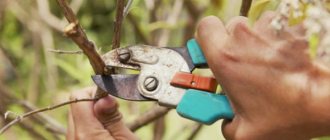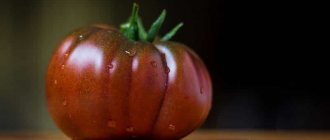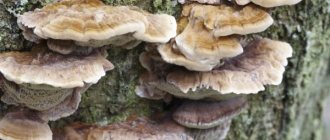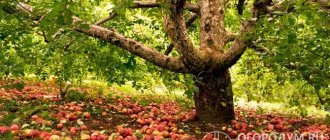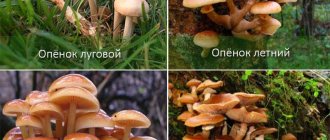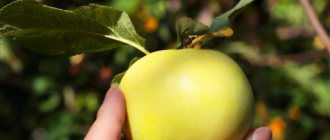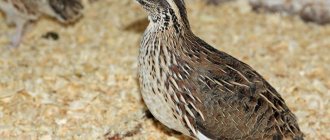Gardening » Apple tree
0
576
Article rating
Kira Stoletova
The Arkad apple tree is relatively new and one of the most popular plants among gardeners. The fruit tree has unique qualities - good winter hardiness, high disease resistance, excellent fruit taste and good yield.
Apple tree variety Arkad
Varieties
Biryukova
A variety of the Arkad apple tree is the Biryukova variety: according to the description, the plant is of medium height - in adulthood it reaches 4 m in height, forms a dense crown of a round shape.
The advantage is resistance to severe winters, the disadvantage is weak immunity to fungal infections.
The tree is characterized by increased winter hardiness, flower buds bloom in mid-May, and fruits ripen in the second or third ten days of August.
Biryukov apples are sweet with a slight sourness, the skin is thin, green in color with a reddish blush and a delicate apple aroma. The size is small - they weigh about 100 g, some larger specimens weigh 120-130 g. From 8 to 10 kg of fruits are harvested from one mature tree.
Sugar
The Sugar Arcade apple tree is early ripening and fast-growing - reaches 5-6 m in height.
The variety has increased resistance to harsh climatic conditions (withstands temperatures down to -35°), therefore it successfully grows and bears fruit in the regions of the Central, Middle and Northern zones.
The fruits of the hybrid form have an excellent taste, thin-skinned, green in color, and sweet and sour in taste. The average weight is 160 g. Harvesting takes place in the last ten days of July.
Apples of this variety have good keeping quality - they do not lose their presentation and taste for 2 months. The crop tolerates transportation well over long distances.
Yellow summer
Yellow summer Arkad is a relatively new, but very popular apple tree variety due to several unique qualities:
- average but stable yield indicators - up to 60 kg of fruit can be removed from one tree;
- golden-colored apples have a sweet-tart taste;
- frost resistance is high - can withstand up to -35°;
- The fruits are suitable for fresh consumption and are used for processing.
The disadvantage of the yellow summer variety is that the apples spoil quickly and do not tolerate transportation well.
Pink
Pink Arcade has a compact shape: the apple tree is about 3-3.5 m high, forms a spreading, weakly branched crown.
The fruits have a pleasant taste
The variety likes to grow on loamy or sandy soil, supplemented with organic fertilizers.
The fruits are small, round in shape - weigh 60-70 g. The skin is light yellow, covered with thin, longitudinal stripes of crimson or pink color. Harvest ripening occurs in mid-July.
Description of the Arkad variety
Gardeners usually choose this variety because of its early fruiting period, because it allows you to enjoy fresh apples already at the end of summer. The trees themselves do not take up much space, they are compact and beautiful, and most importantly, resistant even to very harsh growing conditions. They do not require careful intensive care, do not require special attention, and are unpretentious to soil, humidity, fertilizers and bait. Beautiful and quite large fruits differ in many shades, depending on the subspecies. Apples are aromatic, juicy and tasty, mostly sweet. Today, only a few subspecies of Arkada are grown on an industrial scale, which is actively being replaced by new, more progressive subspecies. It is cultivated quite often in individual household plots due to its unusual sweet taste.
Apples: what they look like
The fruits are medium or slightly larger than average.
They barely reach a weight of 95-130 grams, and only with good, timely care and feeding. They can be round, spherical, but more often flattened or conical-oval, elongated, turnip-shaped. The fruit is symmetrical, one-dimensional, the ribbing may be noticeable or smoothed, the side seam is usually not visible. The skin is dense, smooth, highly glossy, shiny, thin, and has neither an oily nor a waxy coating even when fully ripe. The main color is light green, green or green-whitish; as it ripens, it can become yellow, lemon or light green-white. The integumentary blush in different subspecies differs significantly in shades and density; it can be spotty, blurry, translucent, or maybe speckled-striped, bright. It can be orange, carmine, pink, crimson, red and bright red, or completely absent. Subcutaneous dots are dark, very small, and poorly visible. It is easier to evaluate the chemical composition using average composition indicators:
- P-active substances (catechins) – 324 milligrams.
- Ascorbic acid (vitamin C) – 4.7 milligrams.
- Fructose (total sugars) – 16.5%.
- Pectins – 1.2%.
- Titratable acids – 0.23%.
- Dry matter – 11.9%.
The pulp is medium dense, fine-grained and very juicy. It has a subtle, pleasant slightly spicy lemonade aroma and taste. The taste in most cases is considered sweet, dessert, and scores 4.1-4.2 on a professional 5-point tasting scale.
Apple tree Arkad: characteristics
Crown and root system
Some call the variety tall, but this is wrong. Any subspecies of Arcade extremely rarely extends above 4-4.5 meters .
Therefore, it can be safely classified as a medium, and sometimes even a natural (natural) semi-dwarf. The crown is predominantly round in shape; at a young age it may appear pyramidal, but over the years it becomes spreading. It is quite thick, the shoots extend from the trunk at right angles and are directed upward, covered with green-brown or brown bark without pubescence. The leaves are quite large, leathery, very dense, smooth, highly shiny, glossy, long-pointed, lanceolate and elongated. The edges of the plate are serrated and crenate, jagged, can be folded like a boat, the nerves are gentle. The root system depends on the rootstock used, but generally it is fibrous, branched, and well deep.
Productivity and pollination
Trees, taking into account their small height, can be safely classified as high-yielding varieties.
From one mature apple tree of the Arkad variety, and from absolutely any variety, you can get at least 75-110 kilograms of delicious, sweet fruit. With high-quality and timely care, as well as favorable weather and climatic conditions, these figures can increase by 15-25%.
The variety is conditionally self-sterile, so it is advisable to plant it interspersed with other early apple trees. In the absence of such within 55-90 meters, ovaries are formed from only 15-35% of flowers. It is customary to spray trees with syrup made from honey and sugar, and place hives with bees in the garden in the spring; all this has a positive effect on productivity.
Winter hardiness and disease resistance
For the most part, Arcade subspecies are very resistant to low temperatures, and at the same time to their sudden changes and jumps. They are not afraid of either the bitter frost or the subsequent thaw, especially if they are properly prepared for wintering. This makes it possible to grow Arkad not only in warm regions, but also in the Urals and Siberia.
The variety does not have immunity to fungal, viral or parasitic diseases. During years of severe epiphytotics, it is affected sharply and abundantly. Moreover, not only the leaves suffer, but also the fruits. Seasonal preventive spraying with fungicides, insecticides and other preparations is recommended to be carried out in a timely manner.
>
Rootstocks and subspecies
There are a lot of different subspecies and subvarieties of Arkada, and it can be grown on a wide variety of rootstocks. It makes sense to say a few words about at least some of them.
| Subspecies | Peculiarities |
| Sugar | The most frost-resistant subspecies, representing powerful, five-meter trees with a dense crown. It is able to withstand frosts down to -38-42°C, which will not even affect the yield. It bears fruit regularly with large sweet apples up to 140-170 grams, they are well transportable, do not have an integumentary blush, and ripen in July. |
| Pink | The crown of this tree is oval, compact, and it itself grows no more than 3-3.5 meters. The apples are small, 75-100 grams, covered with speckled-striped pink or pink-raspberry blush. The shape of the fruit is flattened, the skin is thick, the consistency is pleasant, the taste is slightly sweet and sour, the aroma is powerful, they ripen in early August and can be stored for 15-20 days. |
| Yellow | In mid-July, and in hot climates even earlier, this Arcade subspecies ripens. Its skin has a distinct yellow color, it is dense, but thin, matte, and breaks easily. The trees are of medium height, well adapted to frost, the crown is more spreading, and its density is less than that of other subspecies. |
| Biryukova | This apple tree has exceptional winter hardiness, so it can be cultivated even in the conditions of Siberia and the Far East. The trees are of medium height, up to approximately 3.5-4 meters, round, spreading, and bear fruit annually. The apples are devoid of blush, green or light green, strongly sweet, but slightly spicy, aromatic, juicy. The name was derived from the surname of the pomologist scientist Arkady Pavlovich Biryukov. |
| Volzhsky | It differs in its later ripening period, around the beginning or even mid-September. Quite large (135-150 grams) fruits are stored somewhat longer, up to 45-60 days in a cellar or a special refrigerator. They are slightly elongated, greenish, with a light and delicate, barely visible integumentary blush on the sunny side. Developed by breeders Lyubov Georgievna Demina and Anatoly Aleksandrovich Kuzmin. |
| Tenkovsky | Fast-growing and fast-growing subvariety Arcade. Gives fairly good harvests every year without interruption. The apples are large, sweet and sour, with an unusual pleasant aroma and consistency. They are ripe by the end of September, and may remain in the cellar until mid-January, and sometimes even longer. Included in the State Register of Selection Achievements. |
Features of culture
The apple tree is a medium-sized crop - the optimal height of an adult tree is 4.5, sometimes 5 m. The crown is weakly branched, the shoots are straight. The trunk and stems are covered with smooth brown bark and do not contain pubescence.
The leaves are green, round, pointed at the tips.
In terms of tasting qualities, the fruits received the highest rating. Apples have a sweet-sour taste, juicy, with a delicate aroma. When fully ripe, the fruits take on a whitish hue.
Botanical characteristics
The Arkad variety is predominantly a medium-sized garden crop. The height of the trees varies between 3.5-5 m.
- the crown is often weakly branched, formed by straight shoots;
- the foliage is green, round in shape, pointed at the ends;
- tree bark is brown, without pubescence.
- fruits of different sizes and weights - up to 120 g, color depends on the species.
Apples are sweet, often with sourness. Productivity is low, up to 80 kg per tree. General frost resistance - up to -30°C. Short-term temperature changes below this mark are acceptable.
Resistance to fungal diseases is low. It is often affected by spider mites, scale insects, aphids, and hawthorn.
Advantages and disadvantages
The description of this culture includes several advantages:
- early harvest ripening - 2-3 years after planting the seedlings;
- annual yield, although not too high;
- drought resistance and good tolerance of sudden temperature changes;
- versatility of crop use and excellent taste.
Disadvantages of the crop include frequent damage to fungal diseases - scab and powdery mildew. But with good care and planting rules, the plant gets sick less often.
The second disadvantage is the short shelf life, so the crop must be quickly used (eaten or processed).
Reviews of Arkad Sugar apples
Arcana sugar apples are very sweet and tasty. I distinguish this variety from all other Arcana. It always seemed to me that apples can only have positive taste characteristics when they are sweet. You can eat them fresh, or you can make jam and compotes from them. We most often use this variety fresh.
Margarita, Kurgan
If you do not have time to spend a lot of time caring for garden crops, plant an Arkan sugar apple tree in your garden; it does not require any special care, but will delight you with very tasty sweet fruits.
Igor, Ufa
This apple tree has practically no drawbacks, except for the fact that the first abundant fruiting begins to occur 7-8 years after planting the seedling. We eat these apples fresh, my wife makes jam from them, and I make very good wine.
Arkady, Kuban
Productivity
All varieties of this crop produce a harvest between July and August. It is important to prevent them from overripening, because... Ripe fruits quickly fall off and spoil.
On average, one fruiting tree can produce up to 7 buckets of fruit per season.
The trees begin to form the first ovaries in the 2nd year of planting and increase the amount of harvest every year. Peak yield occurs in the 5th-6th year of cultivation.
The plant is self-sterile, although it blooms magnificently every year. When planting with it, you need to plant early flowering plants that act as pollinators.
Reviews from gardeners
Arkad includes several unique varieties: Biryukova, Sugar, Yellow and Pink. They have good fertility, winter hardiness, ease of care and early ripening.
Not all Russian residents grow apricots or peaches in their dacha or garden, but almost everyone plants apple trees. These fruit trees are less demanding, their fruits are well transported, stored for a long time, are universally used, rich in pectin, organic acids, and vitamin C. The Arkad apple tree is grown to obtain an early harvest of large and sweet apples. The fruits are white-green in color with thin skin and juicy pulp and ripen by early August.
Winter hardiness and disease resistance
This crop has increased winter hardiness and can withstand temperatures down to -30°.
Thanks to this quality, the plant is successfully grown in the European part of Russia, the Urals and Siberia. The highest yields are observed when planting in the southern zone of the country.
The variety can withstand frosts down to minus 30
The description of this culture includes weak resistance to fungal infections. Often damaged by spider mites, scale insects, aphids and hawthorn. Often suffers from invasion of weevils and flower beetles.
Diseases and pests
In some years, the Summer Arcade variety may suffer from scab. It often happens that folk remedies and prevention do not save the tree from this serious illness.
In such cases, they resort to chemical treatment of trees against infections - the Venturia unequal fungus, which causes scab.
An alternative to chemicals in treatment and prevention can be mineral fertilizers. This method is cheaper than expensive chemicals and is equally effective.
In addition, mineral fertilizer is useful as a tree feed.
As a preventive measure, spraying with solutions of up to 3% concentration of ammonium nitrate, potassium chloride, potassium salt , etc. helps, and for treatment, solutions of 3-10% concentration of potassium chloride, 10% concentration of ammonium nitrate and 10-15% concentration of potassium nitrate salt.
As with chemical fertilizers, you need to be careful in dosing.
The indisputable advantage of the Arkad summer (or Arkad yellow) variety is its resistance to unfavorable conditions. However, due to the impossibility of transporting the fruits, this variety is more suitable for personal and home garden cultivation; the fruits are unsuitable for technical processing due to their loose pulp.
Also an obvious disadvantage is the low yield and high susceptibility to scab , which requires additional tree care.
Secrets of successful cultivation
The growth, development and fruiting of this tree depends on several factors:
- Quality of planting material. The seedlings should be 1-2 years old, and it is better to take them from the nursery. Before planting, the root system of plants is soaked in a clay mash. After 2 hours of soaking, the roots are dried and slightly shortened (by 2-3 cm in length).
- An area where soil-depleting crops have not previously grown is suitable for planting. The tree should be planted in a sunny place, because in the shade it will grow slowly and bear little fruit. Choose a windless place in the garden.
- Loamy soil, which is harvested in the fall, is suitable for planting. A bucket of rotted manure, 1 kg of wood ash, 50 g of potassium and superphosphate are added per m². The soil is dug up and leveled. Some gardeners apply the nutrient mixture directly to the planting holes a couple of weeks before planting.
Deadlines
In the southern regions, both spring and autumn planting are allowed. The optimal time in spring is mid or late April, in autumn - the first or last ten days of September.
In regions with a cool climate and harsh winters, this procedure is carried out in the spring, as soon as the threat of the last frost has passed. Over the entire growing season, the plants will have time to adapt, take root and strengthen for the upcoming winter.
Landing scheme and technique
For seedlings with a compact crown, holes are dug at a distance of 4 m from each other and 2 m for columnar varieties. The optimal depth is 80 cm, width is 60 cm.
One peg is driven into each hole to support the seedlings. The hole is filled halfway with garden soil, then the roots are lowered, straightened, and covered with soil.
When planting, it is important that the root collar remains above the soil surface, otherwise the tree will quickly rot and die. The trunk area is thoroughly trampled, the trunk is tied to a support. After planting, the tree is watered with warm, settled water - 3 buckets per tree.
Features of planting young seedlings
Before planting a young apple tree, you need to decide on the time of planting, as well as the location, and prepare everything necessary for this process.
Important! It is better not to plant young seedlings in place of an old apple tree. Firstly, there is a weak supply of nutrients and you will have to constantly use fertilizers. And secondly, the causative agents of many diseases, as well as the larvae of insect pests, probably remained in this place.
Optimal timing for planting work
In warm southern regions, planting in both spring and autumn is allowed. In spring, this occurs in the second half of April. Autumn planting should be done at least 3-4 weeks before the onset of persistent cold weather (late October or early November). In cooler regions with cold winters, spring planting is preferable. This will give the trees a chance to take root and gain strength before wintering.
Selection and preparation of a landing site
The key points in choosing a place to plant different varieties of apple trees are practically the same:
- trees need a sunny place. Partial shade is also allowed, since, as the apple tree grows, it is able to win enough light for itself next to low plants. But a shaded place is unacceptable;
- you can choose an open, elevated area. But a windy area is not entirely suitable for high-quality pollination, so you can plant shrubs (rowan, lilac or sea buckthorn) nearby for protection from the winds;
- Close proximity to groundwater is undesirable, which can cause rotting of the root system and death of the apple tree;
- It is preferable to choose areas with light loams;
- if you have a choice, then you do not need to plant in the place where fruit crops previously grew. It is advisable to sow such areas with legumes or meadow grasses before planting (2 years in a row).
The site for spring planting is prepared in the fall, and for autumn planting - at least 2-3 weeks before planting.
Important! For autumn planting, the absence of foliage is mandatory (the tree has prepared for winter), and for spring planting
-
the buds have not yet bloomed.
Seedlings in containers are planted in the spring, when the threat of frost has passed. The following actions must be taken:
- Remove weeds and plant debris from the area.
- Dig a hole approximately 80x80x80 cm. When placing several seedlings nearby, maintain a distance of about 4–5 meters.
- The top fertile layer of soil is mixed with rotted compost or peat (about a bucket), you can also add 0.5 kg of wood ash and a handful of superphosphate.
- The fertile mixture is placed at the bottom of the hole.
- If planting is done on a clayey area, then the bottom is covered with drainage made of stones to improve aeration, and if the area is sandy, then the bottom is covered with clay to conserve moisture.
- It is advisable to mix clay soil with peat, compost or coarse sand, and add a little more compost or humus to sandy soil than usual.
- A peg is driven into the hole as a support.
How to plant a seedling on a plot
When purchasing a young plant there are some points to consider:
- it is preferable to make purchases in specialized places (shops or nurseries);
- It is not advisable to purchase leafy seedlings (they were dug up early and were not prepared for winter);
- for annuals, the height should be in the range of 120–130 cm, and for biennial plants - about 150 cm. Deviations from the standard are explained by improper care;
- the bark should be light, without damage;
- root length - at least 30 cm. Roots - moist, light, healthy. The root system of a high-quality seedling should be branched and have many small roots;
- two-year-old seedlings must have at least 3 skeletal branches, annuals must not yet have branches;
- grafting height - 7–8 cm;
- Each specimen must have a tag with information about the variety.
Before long-term transportation or if the seedlings cannot be planted immediately, the roots should be placed in a clay mixture and then wrapped in damp burlap.
With the hole prepared and fertilized in advance, further planting technology is quite simple:
- The seedling is placed on an earthen tubercle located in the center of the hole.
- The root system is evenly distributed over the surface and sprinkled with soil.
- If the soil is dry, then watering is carried out. The soil is compacted as it is added.
- You need to be careful not to fill the root collar with soil (it should be at ground level).
- A small depression is formed around the apple tree to retain water.
- About 2 buckets of water are poured under the seedling.
- The ground is mulched with peat or humus.
- The tree is tied to a support.
Video: instructions for planting an apple tree
Beginning gardeners need to remember a few tips when planting an apple tree:
- the root collar should be at ground level or slightly above it. In a plant with a deep root collar, the growing season slows down, and if it is located high above the ground, the root system will dry out;
- The root collar is located on the border of the transition of bark color from green to light brown. It should not be confused with the vaccination site located above;
- Before planting, the roots can be soaked in a solution that stimulates root formation (for example, “Kornevin”). The root system can also be placed in a clay mash. This will improve traction;
- Do not overuse fertilizers. This leads to the death of some microorganisms that convert fertilizers into compounds necessary for plants.
Rules of care
Watering
Regular moistening of the soil in the tree trunk zone. Watering is carried out as the top layer of soil dries and taking into account weather conditions. In dry summers, water more often - at least once every two weeks; during the rainy season, the frequency of watering is reduced to avoid rotting of the root system.
Loosening the soil
A day after each watering, the soil is loosened - this procedure allows you to maintain good moisture and breathability of the soil.
Additionally, you can plant useful vegetation on the site - mustard, vetch, green peas. These crops provide good oxygen access to the tree roots and protect the garden from parasite invasion.
To avoid drying out of the soil and excessive growth of weeds, the tree trunk area is sprinkled with mulch from peat, last year's manure or garden soil.
For full growth, development and fruiting, the tree requires a balanced diet consisting of organic and mineral fertilizers. Starting from the age of three, seedlings are fed with nitrogen-containing preparations (nitrophosphate or ammonium nitrate).
Top dressing
Trees need regular feeding
Nutrition in early spring ensures intensive growth of the aboveground and underground parts of the tree.
Before flowering and during the fruiting phase, the tree is fertilized with potassium nitrate and superphosphate.
Apple trees require the same composition in late autumn (after leaf fall), which significantly increases immunity from disease and frost. For foliar feeding, gardeners use the preparation bud or ovary.
Spraying is carried out at the initial stage of tree flowering, in dry weather, early in the morning or in the evening.
Trimming
According to the description of the Arkad variety, the apple tree must be pruned annually.
This manipulation is carried out every spring and autumn - all broken branches damaged by winds, frosts and diseases are removed. A procedure for thinning the crown is also necessary - all branches growing inside the crown are cut into a ring. The cut areas are treated with copper sulfate and covered with garden pitch.
To create the correct crown for compact varieties, shaping is necessary - this begins immediately after planting the tree. First, shorten the central branch by 20 cm in length. The next year, the central conductor and side branches are trimmed to 15 cm in length.
The strongest skeletal shoots are selected, and all the rest are cut into a ring. In the third year, shoots of the second order are formed - 2-3 of the strongest shoots are left, the remaining branches in the row are cut out.
At the 8th year of life, the tree undergoes anti-aging pruning - all five-year-old shoots are cut out completely, and young growth is shortened by 1/3 of the length.
Preparing for winter
All preparatory work is carried out before the first frost occurs.
- First, the area is cleared of plant debris and carrion.
- Then all damaged branches are cut out from the tree, and the cut areas are covered with garden varnish.
- Water-recharging irrigation is carried out to increase the winter hardiness of the plant.
- Tree trunks are treated with slaked lime, the crown is sprayed with copper sulfate.
- A nutrient composition of superphosphate, potassium salt and nitrophoska is added to the tree trunk area, then mulched with peat, last year’s manure or garden soil.
- To protect the tree from rodents, the lower part of the trunk is wrapped with a fine metal mesh, then covered with spruce branches or roofing felt.
Disease Prevention
The procedure involves treating the tree trunk area and crown in early spring and late autumn with copper sulfate or Bordeaux mixture. Insecticides used against parasites are Actellik, Fundazol, Aktaru or Bazudin.
Spraying is carried out twice and two weeks after treating the trees with antifungal drugs.
Frequent problems when growing varieties
Representatives of this variety are most often affected by scab and powdery mildew, as well as pests such as spider mites, aphids, weevils and other parasites, so the following techniques are practiced:
- in case of manifestations of powdery mildew, it is advisable to spray the apple trees with 3% Bordeaux mixture or “Healthy Garden” or “Zircon” preparations, which also increase immunity to scab and most pests;
- “Horus”, “Strobi” or “Gamair” are effective in the fight against scab;
- In case of pest damage, insecticides “Aktellik”, “Fitoverm” or “Fundazol” are used according to the instructions.
To use less chemicals, you can use the following methods:
- mint, elderberry, sage or rosemary planted nearby will help resist infestations of mites, moths and weevils. And in the fight against aphids, plantings of tobacco, nasturtium or calendula are effective;
- enemies of insect pests will be attracted by plantings of mustard, coriander or dill. Such insects are ground beetles, lacewings, ladybugs and other beneficial insects;
- effective use of various traps. A tire filled with water, placed around the trunk, will become a barrier to many pests. Hunting belts can be made from any fibrous material (for example, tow), simply by wrapping them around the trunk at a height of about 70 cm (the width of the belt is at least 20 cm).
To limit the risk of various diseases and pests, it is advisable to carry out preventive measures:
- trim the crown;
- carry out spring spraying with a 1% solution of Bordeaux mixture;
- destroy disease-affected plant remains;
- clean the tree trunk area from weeds, carrion and fallen leaves;
- dig up the tree trunk circle and sprinkle with a layer of mulch;
- clean the trunks of old bark and whiten them with lime;
- use fishing devices;
- disinfect garden tools;
- process cuts when pruning.
Arkada sugar apples may not be stored for a long time, but this shortcoming is fully compensated by the honey taste of the fruit and incomparable aroma. For this reason alone, these apple trees deserve to grow in our gardens.
Ripening and fruiting
The apple tree will delight you with a harvest in July
Flowering begins in conditions of stable warmth and occurs in early or mid-May. The fruits ripen at the end of July or early August. Remove them by unscrewing until they begin to crumble.
The first fruits on a columnar tree appear already in the 2nd year of cultivation - a young tree can produce up to 3 kg of juicy and tasty apples. All others begin to bear fruit in the 3rd year of cultivation.
The highest yields are observed on trees five or six years old.
Most hybrids of this apple tree produce a harvest that can be stored for no more than a month. Therefore, apples are immediately processed for preparing various preparations for the winter. A small amount can be stored in a refrigerator or basement, but the fruit must be consumed within a month, because... with longer storage they lose their taste and presentation.
Apple tree Arkadik. Subspecies and options
On a dwarf rootstock
The height of this variety of the Arkadik variety does not exceed 2.5 m , its frost resistance is much higher than that of a tall apple tree. This subspecies is convenient because it takes up less space on the site and does not shade it much.
Columnar
Columnar varieties of Arkadika are a compact tree with a very modest crown. With proper agricultural technology, their yield is not much different from the classic variety, but you should pay special attention to soil care.
Secrets of floriculture: caring for orchids in autumn and winter at home
Fruits of the columnar apple tree Arkadik.
Summer yellow
This subspecies is distinguished by smaller fruits , which does not affect their taste. One of the negative qualities is the susceptibility to scab.
Sugar
A very productive species (up to 200 kg per tree), the fruits have excellent taste and externally have an excellent presentation. There are no special care requirements. The same recommendations as for Arkadik will be effective.
Pink
This variety bears small fruits (weight does not exceed 80 g), they are flatter in shape than the classic variety, and the yield is low. The trees are weak-growing, the type of fruiting is ringed .
Arkadik pink.
Caring for representatives of the Arkadov family
Arkad apple trees are presented in several types. “Arkad Summer” (Yellow) is the oldest representative of the family; other species were bred on its basis. "Arkad Sugar" has a number of advantages compared to other "Arkadians". But, given the different ripening periods, both summer and autumn “Arcade” varieties will not be out of place in the garden.
Regardless of which type you choose, it is recommended to follow comprehensive care measures:
- The first step in growing an apple tree is planting a seedling. It is recommended to buy seedlings only in specialized nurseries. When choosing, pay attention to the condition of the root system; it should not be damaged.
- To plant, dig a hole about a meter deep, insert a peg into it, which will serve as a support for the young seedling. After planting, provide the seedling with good watering; on average, you will need about 2 buckets of water.
- Don't forget about fertilizers. Use them during planting, as well as during the subsequent years of tree development. If you add a sufficient amount of fertilizer when planting a seedling, then you don’t have to fertilize the plant for the next 2 years. The young tree will have enough nutrients added to the soil during planting.
- Please note that not all members of the Arcade family are disease resistant. Do not forget to treat trees with biological preparations.
- A significant role in caring for apple trees is their preparation for winter. You love apple fruits, but hares are not averse to eating their bark. To protect trees, wrap them with foil or agrofibre. This will save you from rodents and protect the plant from frost.
Arkad apple trees are relatively old varieties, but this does not stop gardeners from growing them in their gardens. Their productivity, although not high, is stable. With proper care, apple trees will provide you with vitamins during the summer season and raw materials for preservation. The varieties are suitable for making juices and jams.
